Stoner 63: Survival Carabiner and Bullpup Rifle
This is a continuation of the article about the Stoner 63 complex. The first part is here.
Almost in parallel with the development of a machine gun installation in a hanging container, work began on the next product. Already in early 1964, Robert Gaddis was appointed responsible for the new project. The reason was a contest announced by the US Air Force on weapon survival for downed pilots. The main requirements for weapons for pilots were: compactness, shooting with .223 Remington cartridges (5,56 × 45 mm), magazine capacity 30 rounds. Weapons with three magazines should fit in a case no longer than 15 inches (38 cm).
The company "Colt" began expeditiously to develop a reduced version of one of the modifications of the M16. As a donor, we chose the CAR-15 Submachine Gun (SMG), also known by the manufacturer’s classification as a submachine gun, model 607. At that time, this model was the most compact rifle of the entire Colt model range. It used the same 5,56 × 45 mm cartridges, it was just that Colt decided to designate it with PP in order to emphasize its miniature, relatively larger overall carbines and rifles. CAR-15 SMG was intended for arming special forces soldiers and crews of combat vehicles.
The manufacturer managed to reduce the size of the donor, and an even more compact model was designated CAR-15 Survival Rifle (rifle for survival). The barrel length was 10 ”(25 cm) and the total length was 29” (74 cm). For storage and transportation, the survival rifle was disassembled into 2 parts, and was equipped with four stores for 20 rounds.
As you can see, the manufacturer tried to minimize the weight and dimensions of the rifle, even to the detriment of convenience and common sense. For example, the pistol grip was cut to the very “I can’t”. Nevertheless, even in this form, the rifle did not fit into a case or case up to 38 cm long. In addition, the CAR-15 Survival Rifle was equipped with stores for 20 rounds, and not 30, as required by the customer.
Stoner 63 Air Force Survival Carbine
The Stoner 63 system was built differently. Take, for example, the butt that Stoner 63 had made removable, but the AR-15 / M16 had it fixed, since a return spring was placed in it. That’s why Robert Gaddis, the new project manager for Cadillac Gage, got a more adaptable platform. He reduced the length of the standard barrel to 15 inches, and reduced the bolt box to the same length. Robert Gaddis shortened the vent pipe to the appropriate barrel and box length. As you remember, a stock was developed for the Stoner 63 system (carbine), which folded to the left. Instead of wood, it was made more ergonomic from polymers. The young gunsmith moved the platoon handle from the left side to the top of the bolt box. It is important to understand that many parts were made from scratch, and in a single copy. The same barrel, gas pipe, bolt box ... And the manufacture of parts was preceded by a long and painstaking work (calculations, drawing up drawings, prototyping, etc.).
Unassembled parts of the carbine and 3 magazines with 30 rounds were stacked in a rubberized case with a 15-inch zipper. That is, the weapon fully met the requirements of the Air Force.
The total length of the carabiner for survival was 33,5 ”(85,1 cm), and with the stock folded 23,75” (60,3 cm). The weight of a weapon with an equipped magazine was 2,8 kg. He retained the ability to fire both single and in bursts. The rate of fire was at 850 rounds per minute, and the initial speed of the bullet was about 820 meters / sec. In addition, the carbine was capable of launching rifle smoke grenades of the M22 / M23A1 type to send signals to search teams on rescue aircraft.
The demonstration of weapons for the survival of the pilots took place at the Aeglin Air Force Base. In addition, the designers asked to evaluate the rifle Stoner 63 ranger squad, which was located at the base, and other units. However, the turmoil with weapons for survival is not good for developers. Neither the Colt CAR-15 rifle nor the Stoner 63 carbine were approved by the US Air Force.
Little was known about the existence of the Stoner 63 Air Force survival carbine. Still, the only instance that has not passed the test. A narrow circle of developers and those involved in the tests believed that it was gone forever. However, in 1994, he suddenly surfaced. What was left of him survived with a collector named Jerry Tarble from Charleston, Illinois. A little has been preserved. If the author translated correctly, then the collector retained: the original barrel with a gas pipe, bolt group (without platoon handle) and pistol grip. Neither the bolt box, nor the butt, but a lot of the little things the collector did not have. He turned directly to the specialist who developed this carbine.
Robert Gaddis handed the collector copies of his original drawings, after which permission was obtained from the competent authorities for the manufacture of the receiver with serial number 0000395, as in the lost original. All missing parts have also been repaired. At that time, collector Mr. Jerry Tarble became the owner of a restored Stoner 63 Air Force survival carbine legally.
Meanwhile, military interest in the Stoner 63 system continued to grow. So, on March 30, 1964, the US Department of Defense placed an order for 80 products, of which 60 were in the “rifle” configuration. The weapon was intended for testing by the Marine Corps. According to press reports, the tests took place at the training center of the ILC, with the participation of recruits (Marine recruits).
The Stoner 63 project was expanding, the team was already crowded in the rooms that were allocated to them at the beginning of the journey. In September 1964, the project moved from Costa Mesa (California) to the Cadillac Gage parent plant in Warren (Michigan). Eugene Stoner and James Sullivan are moving there.
In April 1965, the Army Weapons Command placed an order for 861 Stoner 63 units. The goal was to test the SAWS (Squad Automatic Weapon System) program, which aimed to find a replacement for the Browning M1918 automatic rifle (BAR). Another order for 1080 items was received on December 20, 1965 from the United States ILC. The Marines also requested sets of interchangeable modules in order to test this weapon in various configurations. There is evidence that the US Air Force also tested the Stoner 63 system.
Stoner 63 bullpup
The next time, "Stoner 63" announced itself in the UK. There, the development of the experimental cartridge 4.85x49 Enfield was in full swing. And the design and development department of the Royal Small Arms Plant (Anfield, London), studied the possibilities and prospects of creating weapons for this munition.
Not so long ago, Sydney R. Hance was an assistant chief designer in an earlier project for the Bull-Pap rifle EM-2. But at that time he was already appointed project manager and led the development team of the next Enfield rifle. Mr. Hans' team began their work with a detailed study of the characteristics of the AR-15, AR-18 and Stoner 63 rifles under 5,56x45 mm cartridges. Then they planned to process each of these samples under their 4,85 x 49 mm experimental cartridge.
At that time, the design of the EM2 rifle had a strong influence on the development of new infantry weapons. Therefore, Sidney Hans and his associates continued their work to create a rifle in the layout of the "Bull Pup". It was not possible to modify the AR-15 according to the Bull-Pap scheme, since this rifle has a return spring located in the butt. But the design of the AR-18 and Stoner 63 allowed to change their layout.
After the British studied the samples of NATO partners, the Royal Enfield factory received the task: to rebuild the ArmaLite AR-18 and Cadillac Gage Stoner 63 rifles according to the Bull-Pap scheme. It is time to embody in metal your concept of an assault rifle under a low-pulse cartridge. Experimental samples based on American rifles were made. They demonstrated that the concept has the right to life. Therefore, the British gunsmiths decided to continue work on their own prototype chambered for 4,85x49. Thus, the two weapons systems of Eugene Stoner served as "demonstrators of the idea."
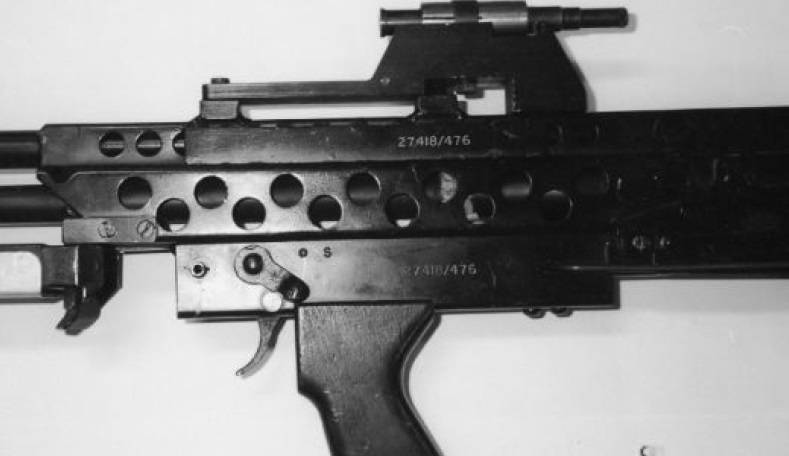
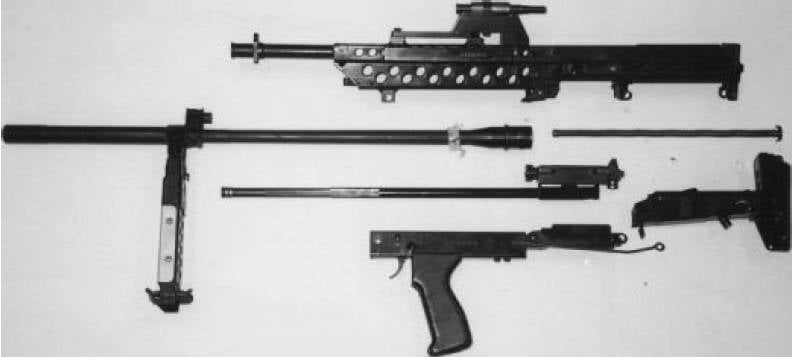
In 1966, the Bull-Pap redesigned AR-18 and Stoner 63 rifles were provided to the British military for their assessment and testing. The military praised both models, but preferred the prototype based on AR-18.
The work lasted 6 years, and on August 10, 1972, gunsmiths from Anfield offered Her Majesty's army a weapons complex, which consisted of an assault rifle and a light machine gun. After lengthy improvements, the complex was put into service under the designation SA80. In the British complex, the locking system and gas outlet were borrowed from the American rifle AR-18. And the Stoner 63 Bullpup rifle was sent to the exhibition of samples of the Royal factory in Anfield (Enfield Museum). The author tried to contact the museum to get better photos of a unique copy. There was no response to his request by mail. Then the author turned to social networks. In a group for Russian speakers in England, a post was posted asking them to visit the museum and take some pictures. Igor Golubev adequately responded to the request (he moved from Riga), but he needed to drive about 100 miles. And then spun story with coronavirus ...
The mysterious modification of the Stoner 63
The author discovered a photo of a rifle with unusual fittings. There is no doubt in the photo of Stoner 63. A lot of things caught the eye: both the front (tactical) handle and the pistol grip of a different shape, with a small angle of inclination, as well as a wooden butt of an unprecedented design.
As you can see, the butt consists of two parts. Its right part is installed parallel to the line of aiming weapons. Judging by a brief comment on the photo - this part of the stock can be moved down and back up. While the lower half is firmly fixed, and located at an angle.
Other explanations for the mysterious configuration could not be found. Judging by the individual details, the lack of a fuse lever in the front of the trigger guard indicates that an unusual sample was made before the modernization of the complex. The length of the barrel indicates that we have a rifle. The author believes that the photo shows one of the intermediate stages of the search for the optimal shape for the future stock and handles for holding weapons.
stoner 66
Designer Robert Gaddis recalled that while working at the small Cadillac Gage factory (Costa Mesa), he received another rifle for testing and evaluation. The only difference from the rest of the Stoner 63 was the lack of a burst mode. According to him, the factory produced about 6 semi-automatic rifles of the Stoner system. This was the result of the idea to enter the civilian market with the proposal of a sports version of the rifle. The civilian version was developed in 1966, so the rifle received the designation Stoner 66. After some time, the Stoner 66 was sent to the parent plant in the city of Warren, where the production of weapons of the Stoner system was unfolding.
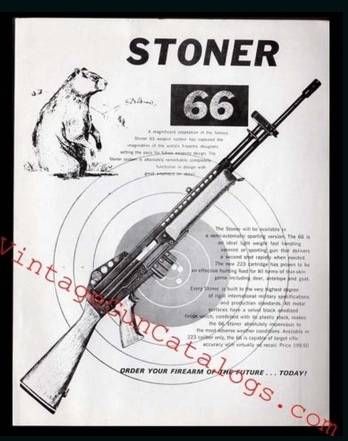
The civilian version of the rifle even began to promote. So, in the magazine "Guns and Hunting" ("Weapons and Hunting"), a review article was published describing the Stoner 66 rifle. The same magazine published several advertisements. From them we learn that the Stoner 66 rifle was offered for $ 199,50. However, the manufacturer was forced to abandon the idea of a civilian version of the rifle.
The fact is that the “Bureau of Alcohol, Tobacco, and Firearms” did not approve the Stoner 66 for sale on the civilian market. Reason: product modular design. Those few produced by Stoner 66 were not converted into automatic ones, but handed over to Cadillac Gage executives.
Stoner 63A
In March 1966, the Stoner 63 system modernization program was launched.
Here is a partial list of improvements:
- the fuse and translator of the fire mode, which were initially made in the form of a single rotary part (flag, as on AKM) - at the request of the military, they were smashed;
- in the updated version of Stoner 63A, the safety lever is located in front of the trigger guard (as on the PPSh or M14 rifle);
- the cocking handle was moved from the left side to the upper part of the bolt box. This decision created convenience for lefties;
- a spring-loaded curtain was added to the ejector window, for less clogging of automation;
- the feeder tray was made by casting rather than stamping, as before;
- the neck of the store receiver was expanded, as a result of which it became faster and easier to join the store;
- the diameter of the gas tube was increased, and it began to be made of stainless steel grade 17-4 PH;
- the pistol grip was hollow, and a pencil case with cleaning accessories was placed in it;
- added mounts for ramrod;
- More ergonomic stocks from polymer, as well as wire stocks, were developed. The latter got along on carbines.
In addition, a 3-position gas regulator was added to the modules for both Machine Gun configurations. Depending on the position of the regulator, the rate of machine guns of the Stoner system ranged from 700 to 1000 rounds per minute. Products manufactured with the above improvements received the designation Stoner 63A.
Important point: Eugene Stoner, Robert Fremont and James Sullivan left the Cadillac Gage before the start of 63A. Unfortunately, the author does not know exactly who was involved in the modernization of the Stoner system.
For convenience, as well as to expand the capabilities of the weapons complex, the following options and functions were provided.
Universal bipod.
In order to increase the stability of weapons during firing for the Stoner 63A system, universal bipods were developed in the form of a bipod. The bipod was quick-detachable and height-adjustable. Made of perforated metal by stamping.
The principle of fixing the bipod to the weapon resembles attaching clothespins to a clothesline. From accidental opening of the bipod, a locking latch was provided. The bipods could be attached both to the barrel (carbine / rifle) and to the gas pipe (light machine guns).
Mount for bayonet.
The weapon of the Stoner system could be joined by a bayonet-knife M7, which was adopted by the M16 rifle. It is noteworthy that the bayonet-knife could be joined not only to the carbine and rifle, but even to a light machine gun.
Seat for mounted optics.
For these purposes, the bolt box provided for the possibility of mounting optical sights and other attachments. It was not Picatinny yet, but it performed the same functions.
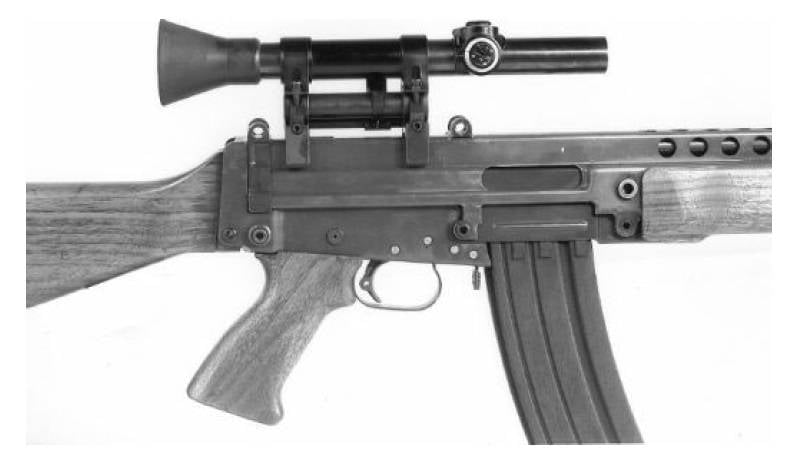
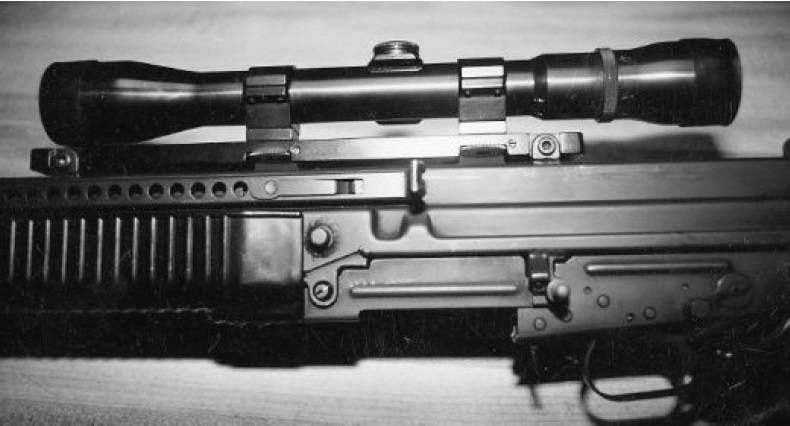
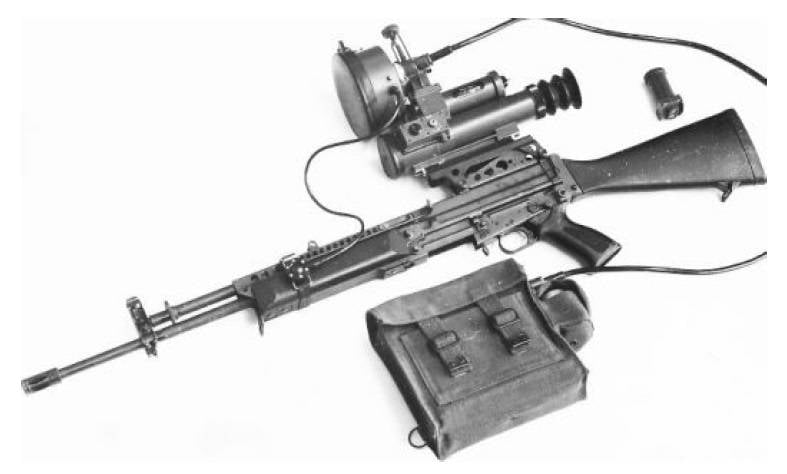
Winter descent (winter trigger).
In order for the fighter to fire from the Stoner 63A even with thick gloves, the trigger guard is removable. With the dismantled bracket, you can shoot even in Arctic mittens.
Grenade shooting.
The trunks of the Stoner 63A complex were equipped with a flame arrester, which allowed firing of M31 rifle grenades. The grenade was mounted on the arrester without any adapters. The launch of the grenade was carried out using a blank shot. By the way, the M1 Garand and M14 rifles also had similar functionality.
The upper product is equipped with a wire butt (folds to the left)
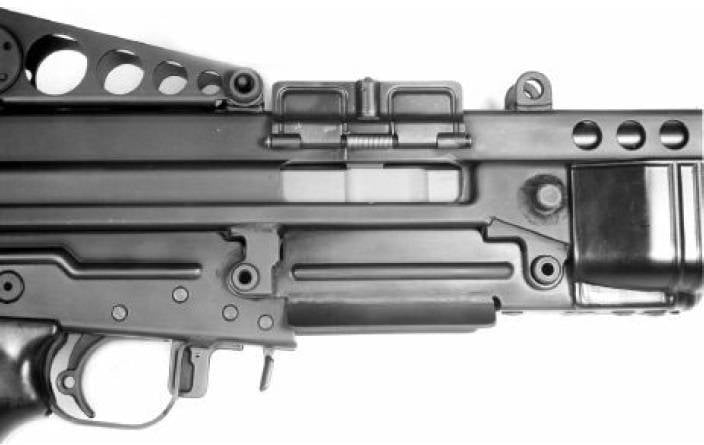
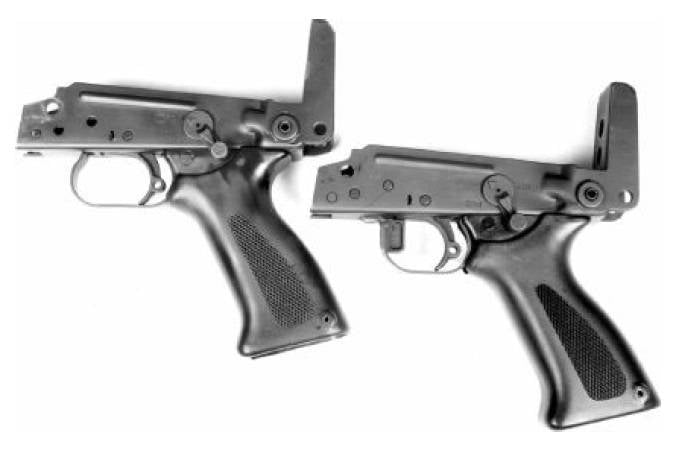
Mauser-Stoner, Stoner 63A1, or The Dutch Trail
At the end of 1963, the U.S. Department of Defense began testing the Stoner 63A system. At the same time, Cadillac Gage decided to sell the licensing rights for this complex abroad. An interest was shown by the Quandt Group company from Germany, in which a certain Mr. Visser (HL Visser) was the director of military sales. Perhaps we are talking about a famous arms collector and businessman from the Netherlands, named Henk Visser. The Quandt Group owned subsidiary arms companies such as Mauser, DWM (renamed IWK) and NWM De Kruithoorn.
Curious fact: Quandt Group is a family-owned company. The founder is Emil Quandt, who at the end of the 19th century successfully married and headed the business of his father-in-law. Since then, the Quandt affairs have been brilliant. They opened up new companies and absorbed competitors. Quandts earned fabulous money by supplying the German army during both world wars. After the Second World War, the empire of the Quandt family consisted of more than 200 companies. Among them are papers by Daimler-Benz (10%) and BMW (30%), as well as VARTA, Altana, and many others. In the mid-50s, two stepbrothers inherited the business: Harald and Herbert Quandt. The most interesting thing is that Harald was the stepson of Joseph Goebbels. To myself. Companion and one of the closest followers of Adolf Hitler.
Herbert Quandt turned out to be a talented entrepreneur. In the late 50s, BMW was on the verge of bankruptcy. Herbert Quandt risked most of his fortune and financed the launch of the BMW 700 Series subcompact. This machine was very popular. Over 6 years, more than 180 thousand cars were sold. Herbert Quandt thus saved BMW from ruin and from possible takeover by Mercedes-Benz. Already in 1961, the proceeds from the sale of the BMW 700 started production of the new BMW model: Neue Klasse 1500. Car enthusiasts know that the BMW 1500 is a direct ancestor of the 3rd and 5th series. This event was a turning point in the fate of the German automaker. And if the production of small cars helped the company stay afloat, the production of sedans with engines of 1,5-2 liters helped to break out into the leaders in the automotive industry.
The author cited the history of the Quandt family in order to demonstrate: they knew how to do great things.
Finally, the parties agreed, and the Quandt Group acquired a license for the Stoner system complex from Cadillac Gage. The rights to manufacture and sell it around the world (with the exception of the USA, Canada and Mexico) were registered at a subsidiary NWM De Kruithoorn.
Initially, the Germans decided that they would sell licensed products under the Mauser brand. Therefore, the “Mauser-Stoner” was marked on the slide boxes of the first demo samples. However, Mauser was not particularly involved in the process. Then Mr. Visser from Quandt Group decided that the weapons factory NWM De Kruithoorn (Netherlands) would be engaged in production.
Perhaps Mr. Visser had serious ties not only among industrialists, but also in the governments of many countries. Otherwise, how to explain the fact that shortly after purchasing the license for the Stoner 63A, the Netherlands Armed Forces showed interest in it. Holland even ordered samples of all 6 configurations for testing. In Europe, their production has not yet been established, so the order was redirected to the United States. So, in 1965, Cadillac Gage delivered to Europe a batch of 20 units that did not undergo modernization of the Stoner 63. The entire batch was sent to the NWM factory: to adapt to the requirements of a potential operator. In the period from 1966 to 1970, additional batches of weapons systems of the Stoner system, but already modernized Stoner 63A, were regularly delivered from the USA to Europe. Total 315 complexes. In total, the Netherlands received 335 units in various versions.
Specialists of the Dutch factory NWM De Kruithoorn transferred the technical documentation to the metric system, made some changes to the design of American designs according to customer requirements, and prepared the production for serial production. At first, changes were made to the design of the Stoner 63A, configuration "Carabiner". A folding stock was developed for him, in many ways similar to the one on the German MP 38/40, and then on the Soviet AK.
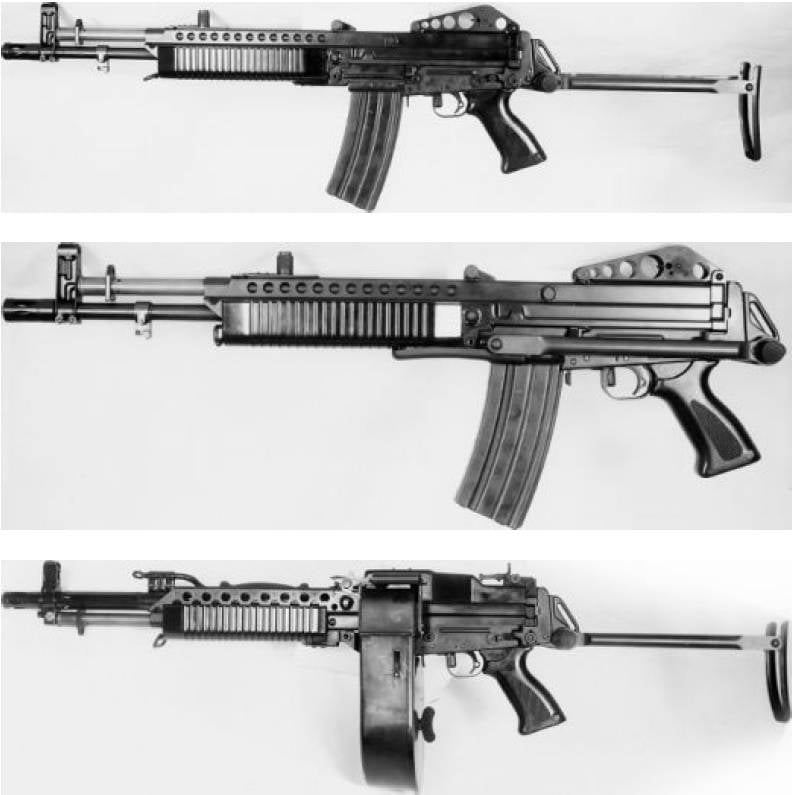
Updated in the Netherlands, the Stoner 63A range was designated 63A1. Some of them (number unknown) were sent to America, for their testing by the US Army and the Marine Corps.
It is known that in the USA the “Dutch Stoners” were delivered in three configurations. In the United States, they all received new alphanumeric characters *. So, “Carabiner” received the designation XM23, “Assault rifle” - XM22, and “Machine gun with tape power” - XM207.
* XM - eXperimental Model (experimental model).
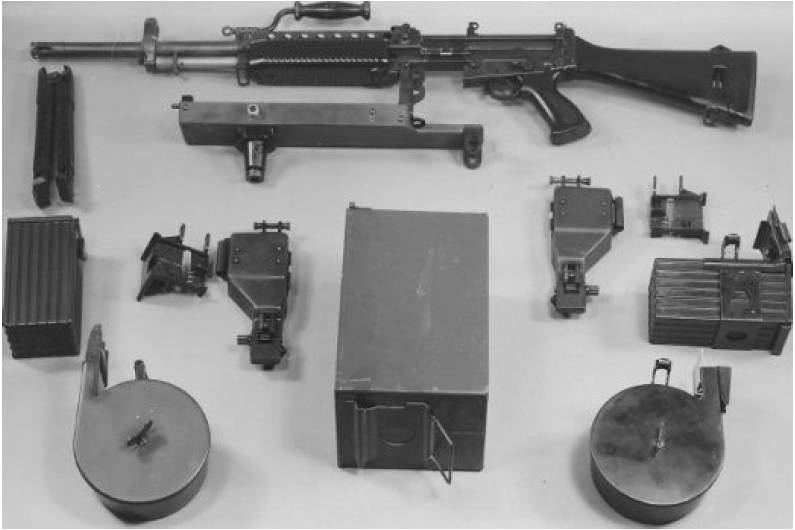
The percentage of unification of the Stoner system complexes manufactured in the USA and modernized in the Netherlands was about 80%. I note that NWM De Kruithoorn has never produced this weapon. This refers to the full cycle.
Owning a license, as well as production facilities that are completely ready for serial production, the Dutch limited themselves to the 63A1 program. The essence of the 63A1 program was the modernization of products manufactured in the USA at the plants of the Cadillac Gage company. Let me remind you, there were 335 in total.
In an effort to find customers, NWM De Kruithoorn has done gigantic work to promote the Stoner 63A1. Demonstrations of weapons staged around the world. In any country that showed even the slightest interest. Some countries were even close to signing contracts for the supply of "Dutch Stoners." We are talking about countries such as: the Netherlands, South Korea, Taiwan, Singapore, Malaysia, Indonesia, Thailand, Israel, Chile, Peru and Spain.
But large deliveries were not destined to happen. The rejection of the Stoner 63 began in the homeland of the weapons complex. The fact is that in the USA the M16 rifle has already been adopted. Also, by the way, the design of Eugene Stoner. US Secretary of Defense Robert McNamara demanded the greatest possible uniformity in both weapons and his service. This led to the fact that the Stoner 63A and 63A1 systems were removed from the agenda in favor of the M16 rifle, which by that time was produced by the Colt company.
After the United States abandoned Stoner 63, interest in the complex also disappeared from other states. Its production was discontinued. However, US Navy special forces (seals) continued to use the Stoner 63 and 63A during the Vietnam War and even many years later. This will be discussed in more detail in one of the following parts. In 1998, NWM De Kruithoorn went bankrupt and ceased to exist. The fate of the "Dutch Stoners" is not known for certain. Perhaps some of them went on sale and became exhibits of private collections. Currently, Knight's Armament owns the drawings and equipment necessary for the production of the Stoner 63 complex. But this will also be discussed later.
To be continued ...
- Mikhail Zadunaysky
- en.wikipedia.org, en.wikipedia.org, patents.justia.com, trademarkia.com, patents.google.com, www.icollector.com, morphyauctions.com, rockislandauction.com, gunbroker.com, armslist.com, ipfs.io, joyreactor.cc coronadotimes.com, northwestfirearms.com, weaponland.ru gunsinternational.com, smallarmsreview.com, defensereview.com, coronadotimes.com, The World's Assault Rifles (Gary Paul Johnston, Thomas B. Nelson)
- Stoner 63: Eugene Stoner's modular weapon system
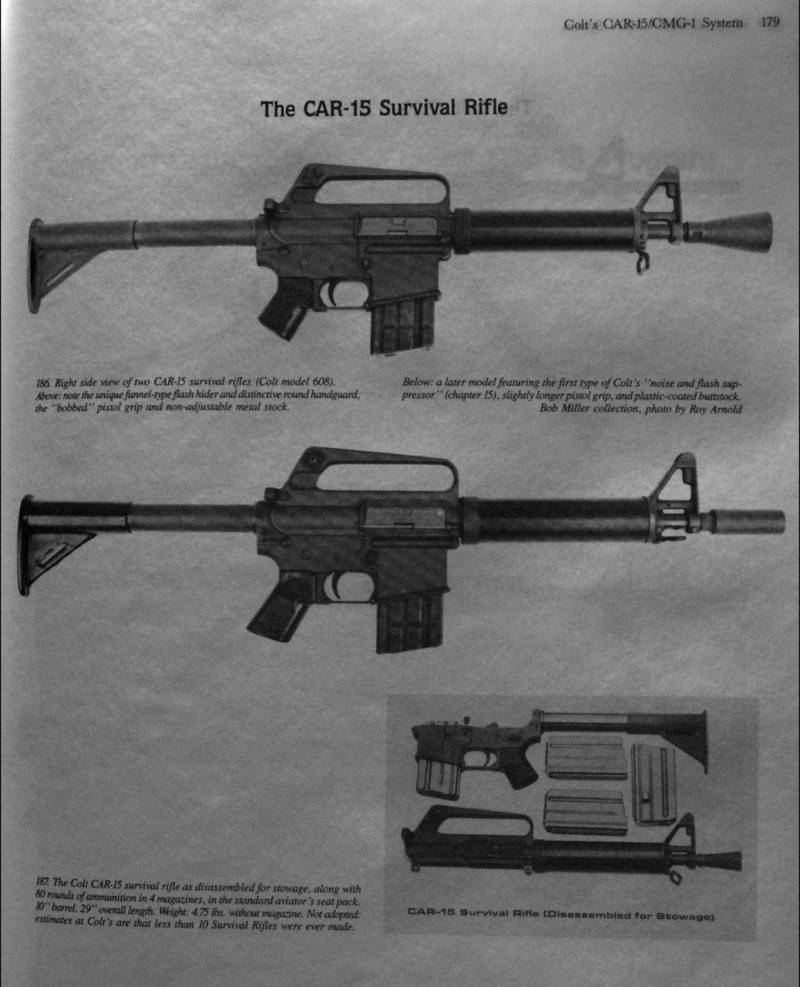
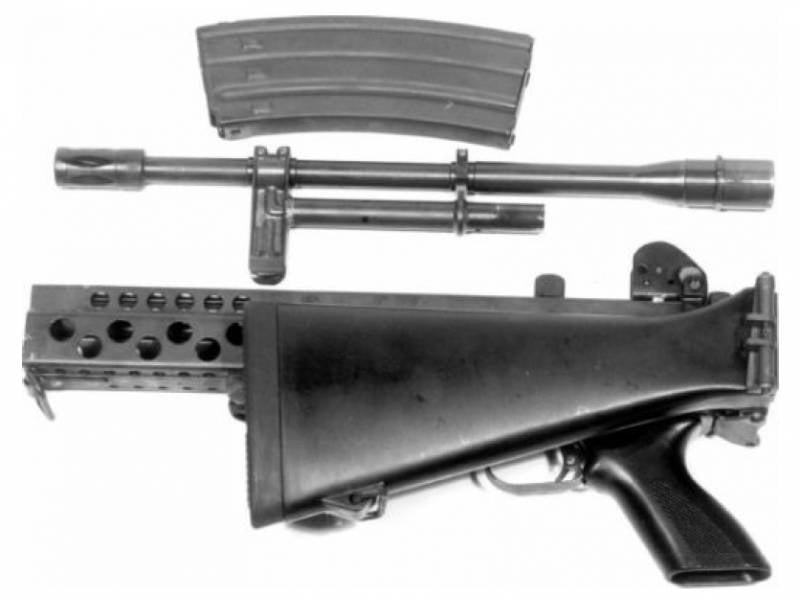
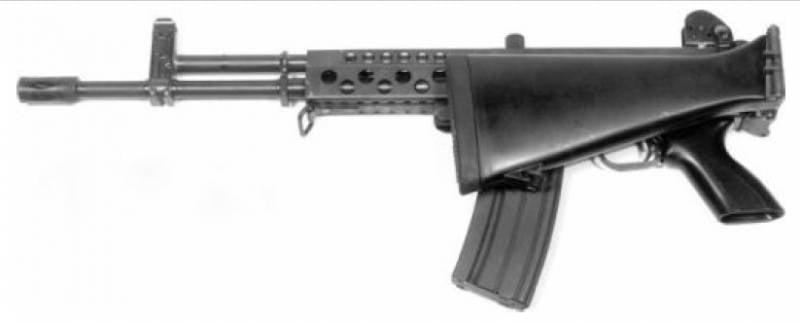

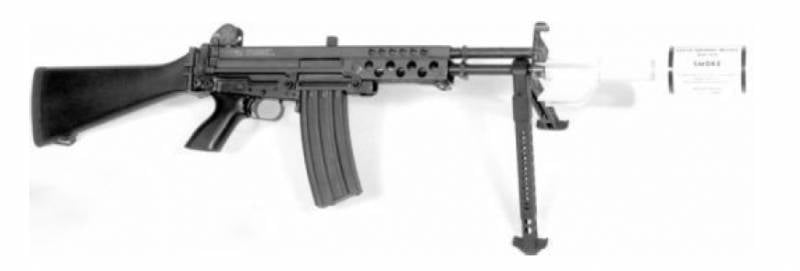



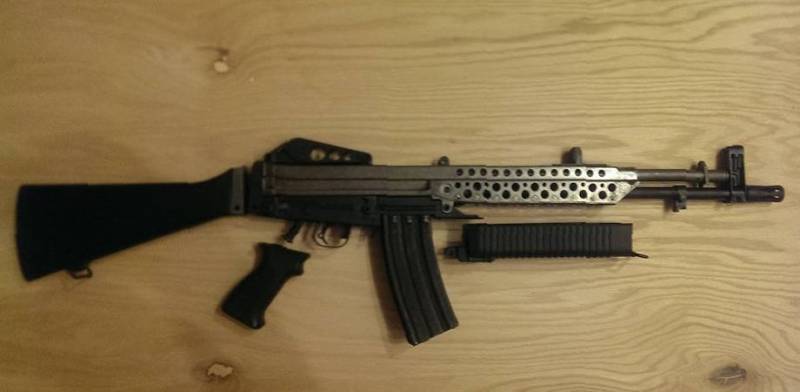
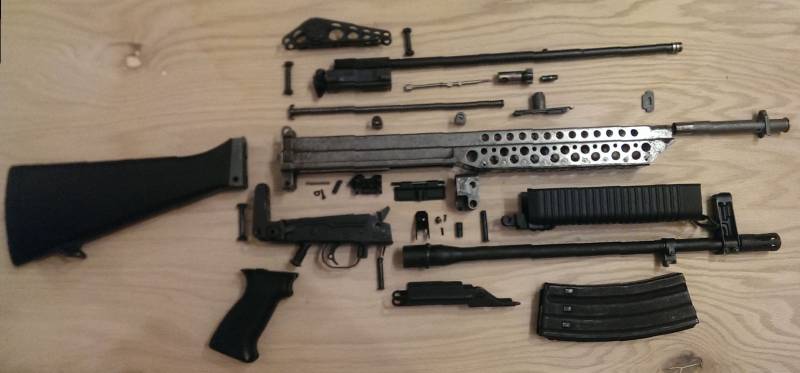
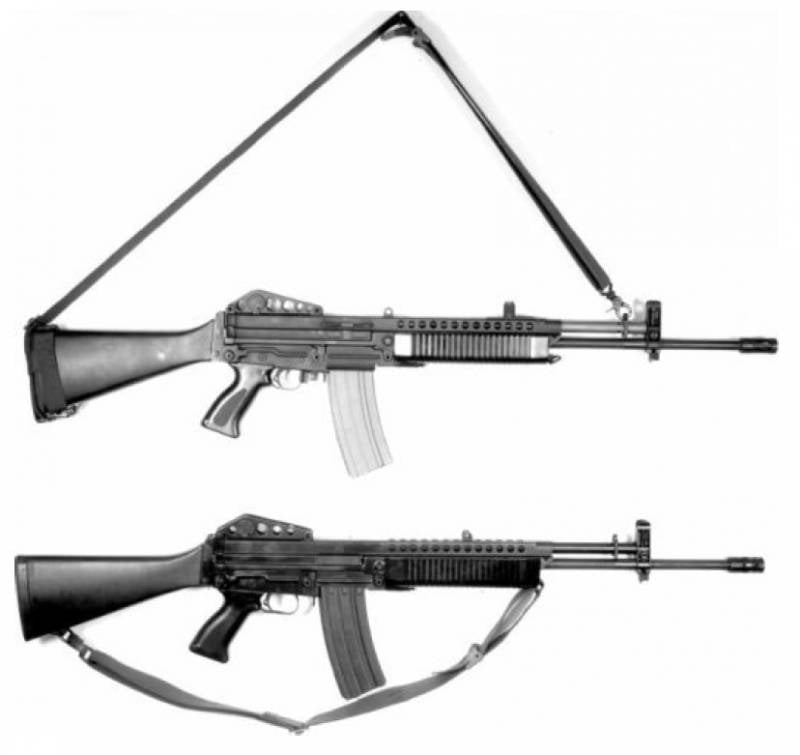
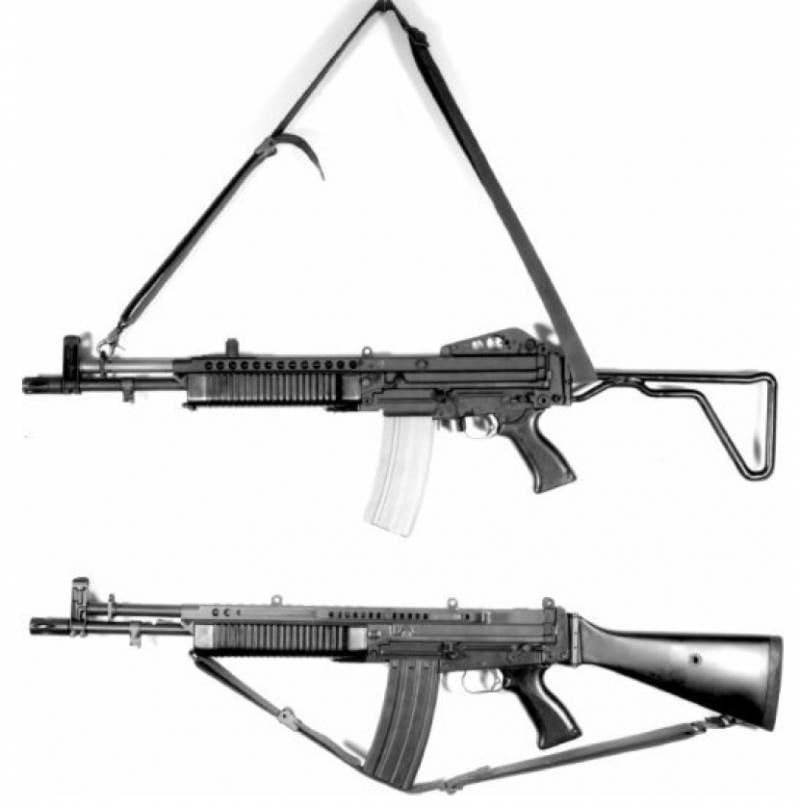
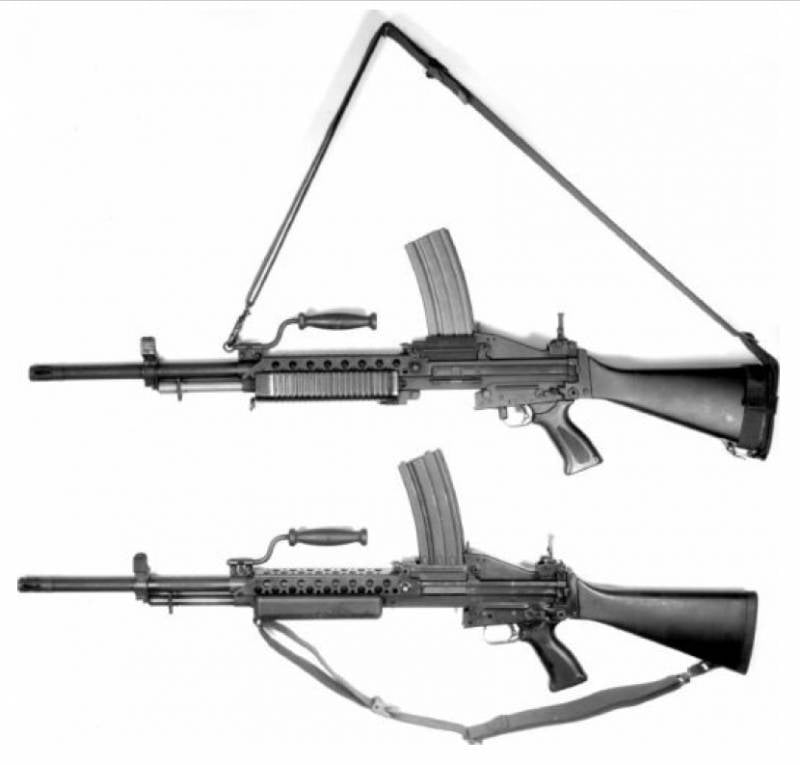

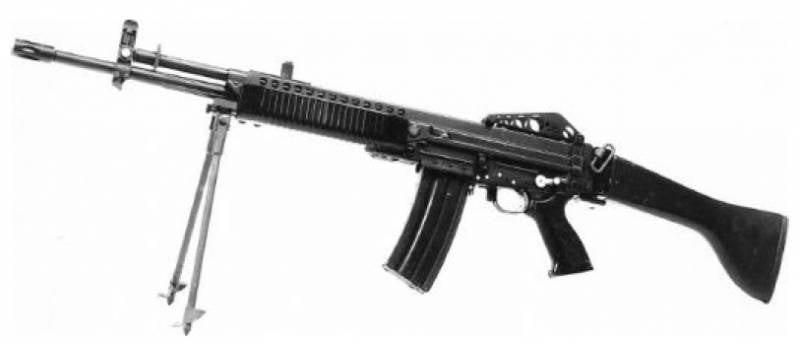
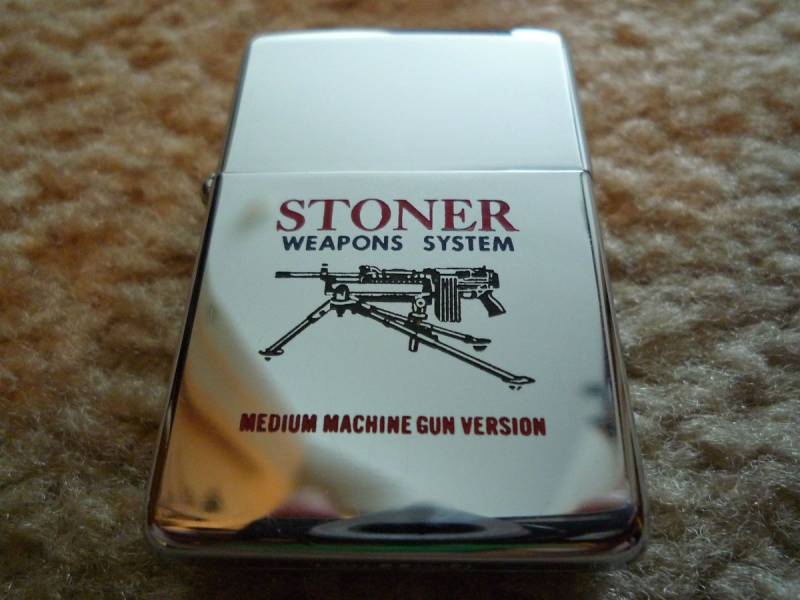
Information